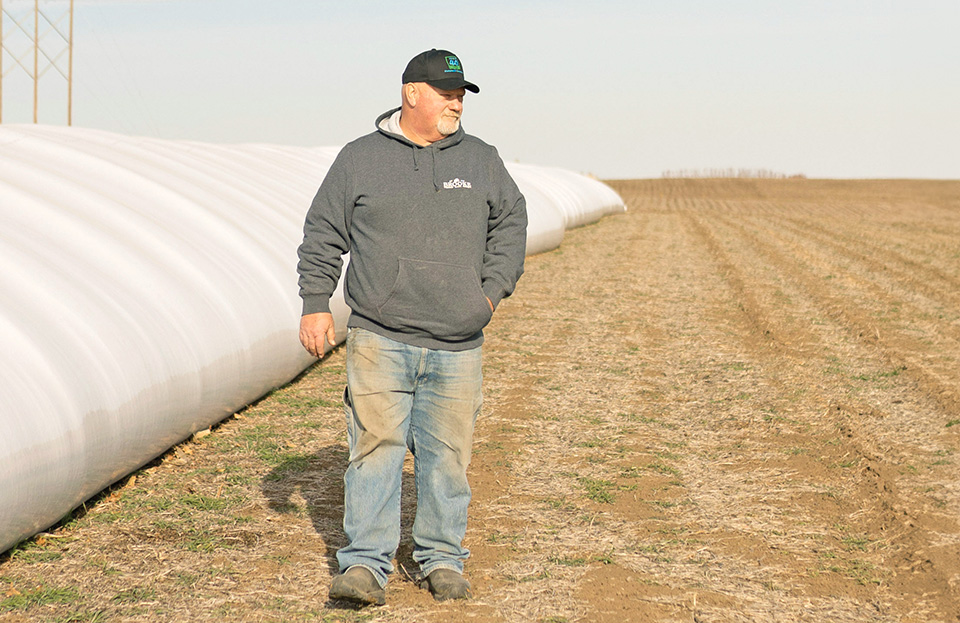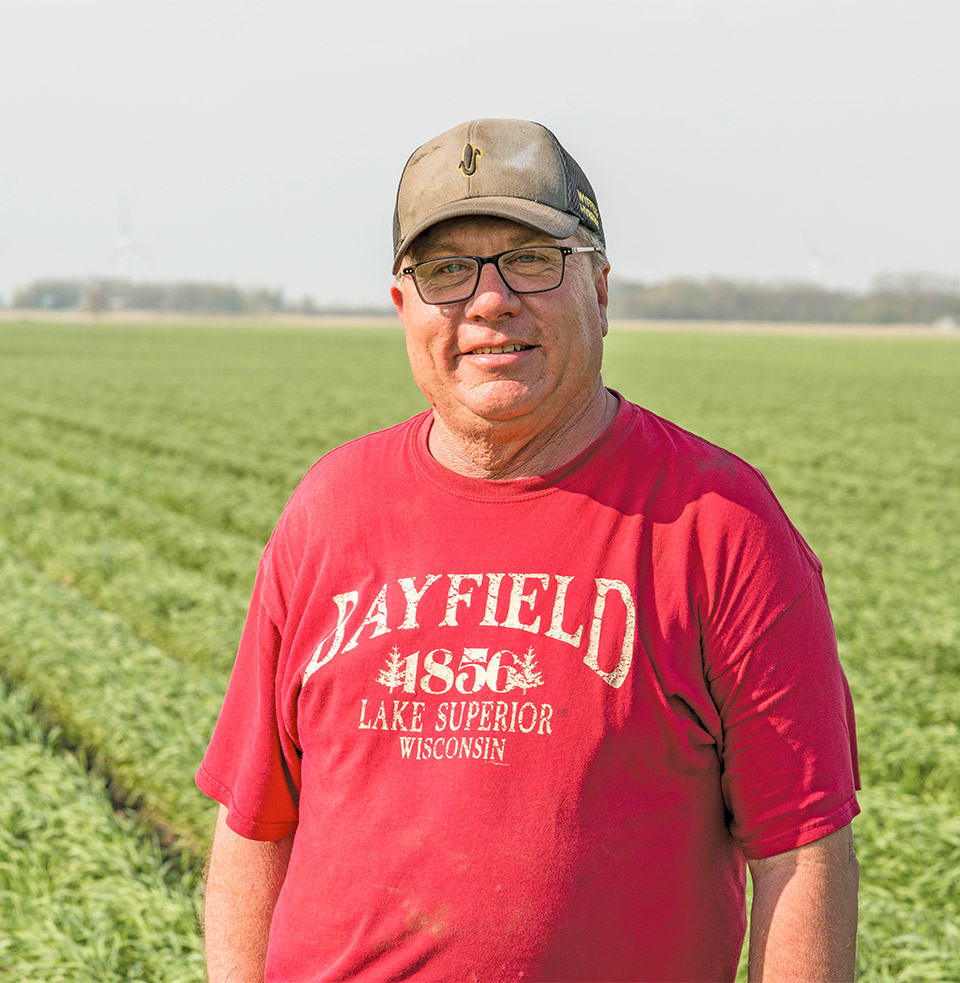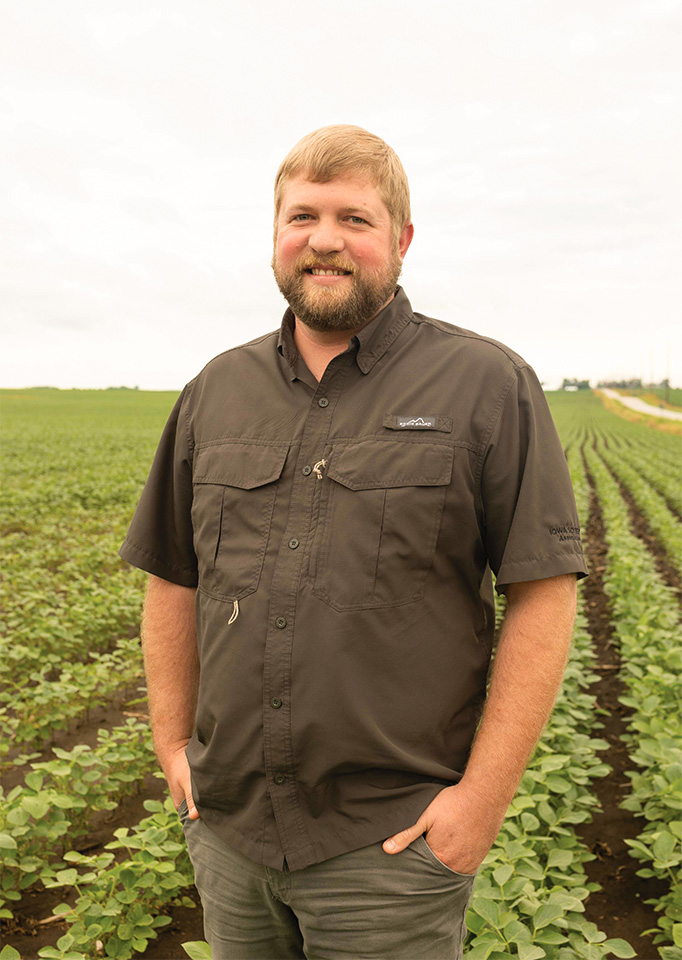
ISA District 7 Director Lee Brooke on his farm near Clarinda (Photo: Iowa Soybean Association / Joclyn Bushman)
Protecting profitability during times of tightening margins
February 5, 2024 | Kriss Nelson
Back to the Basics
Crop management includes a wide array of aspects, including cultural practices, agronomic inputs and the environment.
“It is important to think about your farm as a web of interactions, and a change in a practice may have a ripple effect or unintended consequence in other areas,” says Iowa Soybean Association (ISA) Research Agronomist Alex Schaffer.
Consider ISA District 7 Director Lee Brooke’s farmland in southwest Iowa. It’s benefited from no-till since 1995.
“No-till has been a godsend for us on our highly erodible soils,” says Brooke, who farms near Clarinda. Terraces and cover crops also work in tandem with no-till to maximize the benefits.”
Because those soils tend to be prone to washing, no-till and other conservation efforts Brooke has implemented have helped to stabilize the soil and he has noticed a significant change in his soil’s ability to conserve moisture.
“Our soils are prone to washing, but we’ve been able to conserve moisture,” Brooke says.
Nutrients
Potassium plays a role in water movement in the plant and uptake of other nutrients. Phosphorus contributes to root growth, which is the mechanism for the movement of other nutrients into the plant.
When deciding what nutrients you need, start with soil sampling.
“Know your soil fertility levels and sample at the same time consistently and under the same environmental conditions,” says Drew Clemmensen, ISA research agronomist.
Comprehending removal rates from grain harvested can also help you make your nutrient decisions.
Iowa State University’s removal rates from harvested corn grain are .32 pounds a bushel for P205 phosphate and .22 pounds for K20 potash.
For soybeans, .72 pounds per bushel of P205 phosphate and 1.2 pounds per bushel of K20 potash.
“These should be used for a baseline amount that should be replenished to maintain levels,” says Clemmensen.
Factors influencing nutrient uptake:
Soil pH
“Nutrients can become less available in soils that are too acidic or too alkaline, so be sure to have a balanced soil pH,” says Clemmensen.
The optimum pH for phosphorus is 6.5–7.5, while potassium availability drops with a pH below 6.
Compaction
“Soils that are anaerobic and compacted reduce nutrient uptake and can hinder root growth, which also limits nutrient uptake,” says Clemmensen.
Residue
Residue can hold large amounts of potassium and phosphorus. Clemmensen advises looking at options to break the residue down quicker to release the nutrients to become available for next year’s crop — essentially feeding the microbes.
For ISA-farmer member Russ Olson, "every acre, every year" is his philosophy regarding his fertilizer program. The Northwood farmer has been practicing no-till and strip-till for nearly 20 years and has been using cover crops every year since 2018. This year, he implemented cover crops on all of his acres.
Northwood farmer has been practicing no-till and strip-till for nearly 20 years and has been using cover crops every year since 2018. This year, he implemented cover crops on all of his acres.
Using variable rate technology (VRT), Olson ensures he feeds the soil where it needs it.
“VRT is a valuable tool,” says Olson. “It allows us to place the nutrients where they are needed and best used.”
Brooke also takes advantage of variable rate technology for his fertilizer program.
His first advice is to lock fertilizer prices in early and capture the savings. Then, like Olson, put the nutrients where they are needed.
“This is especially important with the high costs of fertilizer we have had the past few years,” says Brooke. “The cost has come down some, but not enough.”
Planting
Consider what planting populations, seed treatments, planting dates, and variety and hybrid selection match your cropping system.
“When it comes to planting date and variety, I suggest spreading your risk,” says Schaffer. “Don’t plant all the same variety and don’t plant everything in the same week.”
Consider planting soybeans once soil temperatures hit 50 degrees and rising with favorable weather conditions in the forecast.
“It might not be a bad idea to switch over to planting corn and spread planting out over a couple of weeks to spread your risk — consider hot weather at corn pollination and grain fill, for example,” says Schaffer. “No matter what, strategize to have all your seeds in the ground by mid- to late- May to avoid losing any yield potential.”
Brooke says he positions his hybrid selection to individual fields.
“We try to match the variables such as different soil types,” says Brooke. “We plant resource hybrids on our best soil and defensive hybrids on our more sensitive soils. We also variable rate plant corn and soybean populations to match soils and yield potential.”
Planter setup
Planter setup, especially in no-till scenarios, means paying closer attention to row cleaners, no-till coulters and a properly working closing wheel system.
“Farmers should do all of these things expecting the seed to be in a more challenging environment at planting and the seedling stage,” says Schaffer. “Ultimately, you are trying to protect the final stand with these management decisions.”
Your crop has the highest yield potential the day the seed is put into the ground, he says.
“It is extremely important to check the job your planter is doing as you start each field this spring,” says Schaffer.
“Take a minute to stop the tractor and get out to dig where you just planted.”
Be on the lookout for:
Seed placement
Is the seed placed into uniform soil moisture at an adequate depth?
Furrow conditions
Is the furrow clean from debris and completely closed, ensuring uniform seed-to-soil contact?
“If not, it will be worthwhile to look at your planter depth setting, row cleaner settings, downforce management and closing system setup to get as close to that picket fence stand as possible,” says Schaffer.
Pest Management
Herbicides
When making seed and herbicide selections, be cognizant of what species of weeds you are battling.
 For example, suppose you are battling small-seeded broadleaves in a field going to soybeans. In that case, selecting a soybean variety with herbicide tolerance and growth regulators, such as an Enlist or Xtend variety, may be advantageous.
For example, suppose you are battling small-seeded broadleaves in a field going to soybeans. In that case, selecting a soybean variety with herbicide tolerance and growth regulators, such as an Enlist or Xtend variety, may be advantageous.
To add to that program, use a soil-applied group 14 herbicide to help battle any glyphosate-resistant waterhemp and other small-seeded broadleaves.
“It is important to keep your Integrated Pest Management plan in mind when formulating a weed management program,” says Schaffer. “Using multiple modes of action in a single year and rotating modes of action across the years will help keep resistance under control.”
Scout for weeds often, Schaffer says.
“A lot of these harder-to-control weeds are fast growing and have a short window to get them killed once they emerge,” says Schaffer. “In my opinion, it is important to scout weekly in the early season to ensure you are aware of early weed pressure when you still have management options.”
Olson plants into standing rye, which becomes a large part of his herbicide program. After several years of terminating rye with glyphosate, Olson changed things up in 2023. He used Flexstar GT successfully.
“We let the rye grow until Memorial Day weekend, terminated it with the Flexstar GT, and were happy with it. It knocked out the few small broadleaves coming through. We then followed later in the season with an Enlist DT pass.”
For Brooke, the earlier the better is his mantra to weed control.
“Our best way to battle weeds is to use the earliest preemergence program you can,” he says.
Brooke has found that planting narrow-row soybeans is beneficial for his soils, and the canopy also helps suppress weeds.
To help get ahead of weed pressure this spring, Brooke made a fall application of 2-4D and dicamba mix to terminate winter annual weeds.
“You may not see the weeds, but they are out there,” says Brooke. “We have done this the past two to three years. It makes sense if we spray the bean stubble in the fall; we start clean in the spring and will only do one herbicide pass in corn.”
Disease and insect management
Scouting and following the disease triangle will help you understand how diseases develop.
For plant pathogens to develop and cause economic losses, there must be the presence of the pathogen, a viable host and the environment conducive to developing these diseases (cool, wet and long periods of dew).
Scouting tips:
Weather
Moisture is critical to most disease development.
“If it has been rainy or periods of heavy dew, there is a potential for disease to develop,” says Schaffer. “If this is the case, walk out into your fields and look for any signs of disease.”
Regular scouting
Schaffer says some of the most successful farmers he works with scout their fields weekly.
Keep records
Using scouting apps or something that helps record information will help you understand what is happening in your fields.
“Often we get in the combine and wonder what happened. A spatially accurate record from the summer would help make management decisions to prevent the same problem in the future,” says Schaffer.
Fungicides
Early fungicide trial results from the 2023 growing season show it was not profitable to apply fungicide to soybeans.
“We are seeing the untreated control yielding just as well as our plots treated with fungicide,” says Schaffer. “We believe a big reason for this was the hot, dry summer limiting disease development.”
When it comes to treating diseases, Schaffer suggests using fungicides when needed — not just in case or prophylactically — because of potential resistance and because there is not always a return on investment.
Also, you could create unintended consequences with other pests. A prime example is creating a favorable environment for spider mite development.
“This happens by eliminating fungi that colonize the spider mites as well as contribute to greater plant health and a better food source for the spider mites,” says Schaffer. “This is why the recommendation is to include an insecticide when applying fungicide as well.”
In this scenario, Schaffer recommends farmers use an insecticide with strong activity on spider mites because not all insecticides work well against battling the insect.
Back